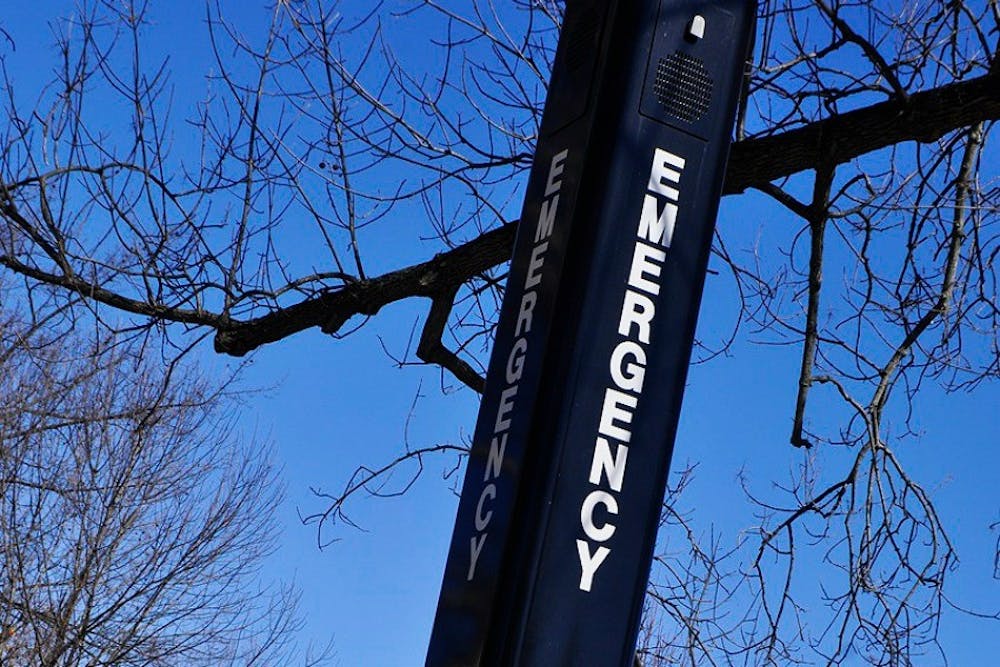By Lauren Oliver, For The Miami Student
In case of a dangerous situation on campus, blue alert boxes at many locations are primed for action to notify the Miami University Police Department (MUPD). Each of those units costs around $30,000, however, according to MUPD Lt. Ben Spilman, the blue boxes are rarely used.
Spilman said students shy away from the alert button due to the availability of cellphones.
Dave Mooring, a graduate student in Student Affairs and Higher Education, agreed cell phones are more immediate.
"I don't think it's useful because the response time is too long," Mooring said. "If someone is chasing me, I would have more success running while calling the police than hitting a button and waiting."
However, according to Spilman, these situations are unlikely. In fact, when it came time to discuss the replacement of the old boxes, Spilman said the police department, along with IT Services, were asked to provide numbers on how often they were used, and after looking back several years, could count less than five times they had been pressed for an emergency.
Spilman said there is no correlation between the lack of usage for alerts and the amount of incidents on campus, but rather represents a change in how people report to the police.
"People are just contacting the police differently than necessarily having to have a box physically installed in so many locations around campus," he said. "Now, we're able to put them in more strategic locations that will allow us to get more audio coverage over the outdoor areas on campus, and still provide a level of safety for people who might not have a cellphone with them."
Miami Director of Network Engineering and Technology Chris Bernard said there was discussion about whether the alert boxes would be a worthy expenditure. After some deliberation, it was decided despite the low operation, the boxes are still of necessity.
"While they have [rarely] been used, there is a certain expectation that parents and students have when it comes to campus safety," he said. "The emergency phones are a visual indicator that we take [students'] safety seriously."
Now, the university has plans to replace the seven yellow boxes with a total of 17 new blue boxes on campus, which have been modified and installed with additional features, other than just for distress alerts.
"[There's the] ability to make an announcement and use them as a loudspeaker, which provides some outdoor warning capability for the University that we've not had before," Spilman said. "[Also], the University IT is able to use them to create Wi-Fi hotspots outdoor … to allow greater access to the university's network."
Enjoy what you're reading?
Signup for our newsletter
Bernard offers the same sentiment and says the new adaptations are valuable.
"While the Wi-Fi is certainly a great benefit, I believe the ability to broadcast information outdoors on a wide scale, however, is probably the greatest benefit to those devices," he said. "With the ever-changing weather in Ohio, the ability to keep people advised of impending bad weather is a crucial safety concern."
Although the boxes appear idle, they receive service checks by the MUPD every month, and there is also an annual campus-wide emergency text sent to everyone who is registered to receive the emergency notifications to ensure they are functioning properly.
Bernard said those close to the project are excited for the future of the blue boxes.
"We're trying to take an overall constructive look and identify the best places for them, as well as physical facilities, and I think we've got a much better coverage than we had with the yellow ones."
Spilman and Bernard are estimating the final installations to be complete by the end of the year; however, each unit takes six to eight weeks to be finished due to the wiring and permit process.
"We've been working on the ones we're installing now for about six months … and it just takes a while to get the pathways in place, as you have to pour concrete, put it in place, program, test and then adjust," Bernard said.




